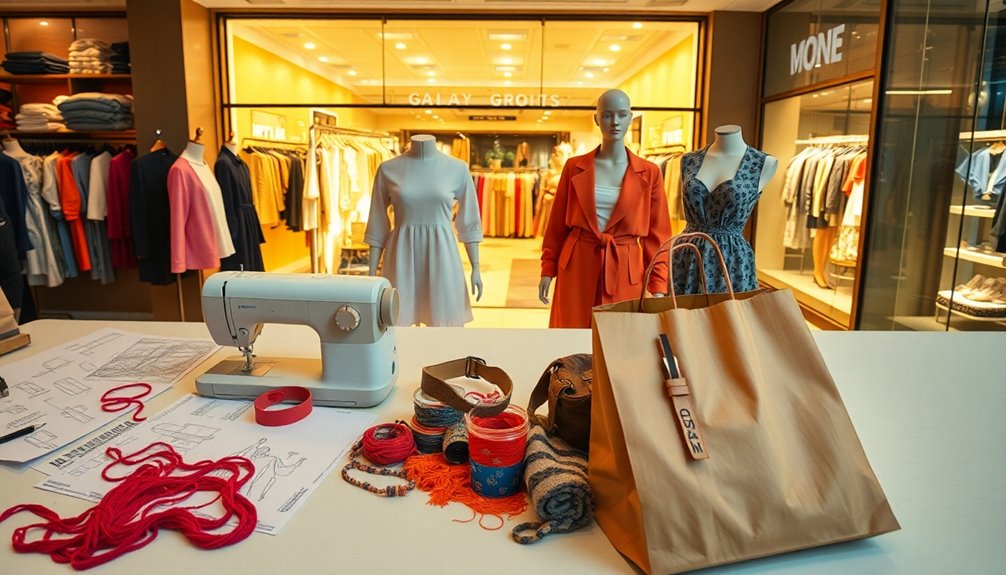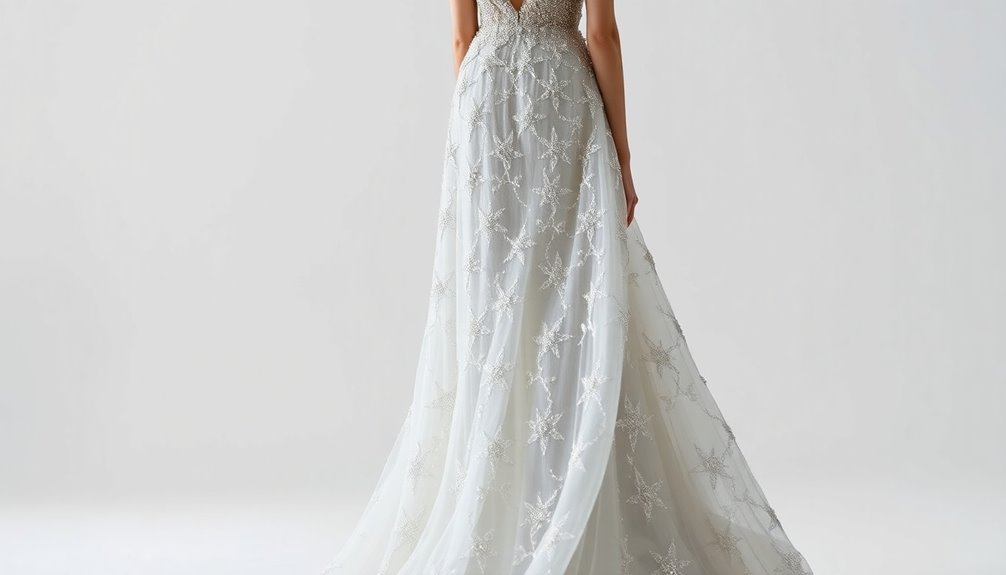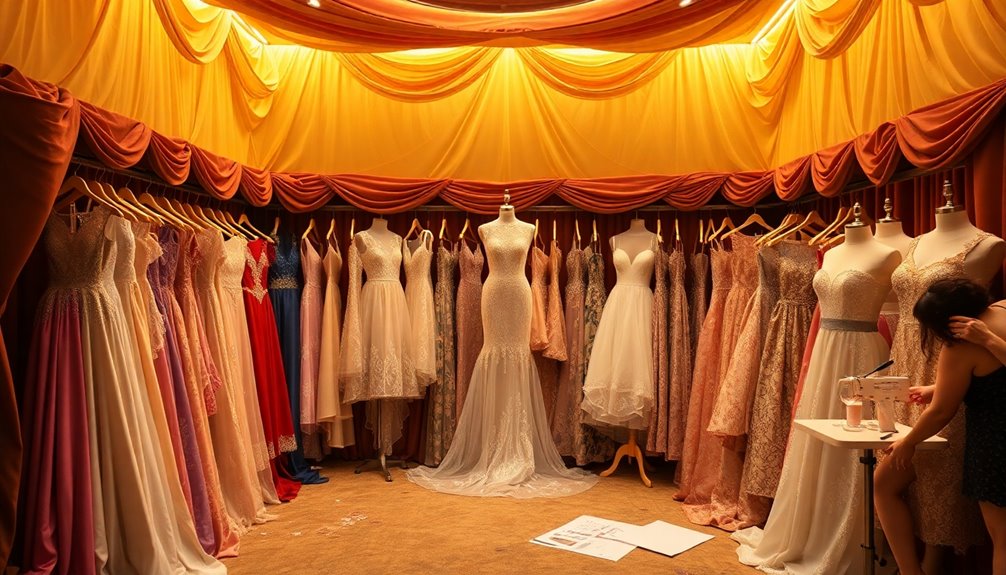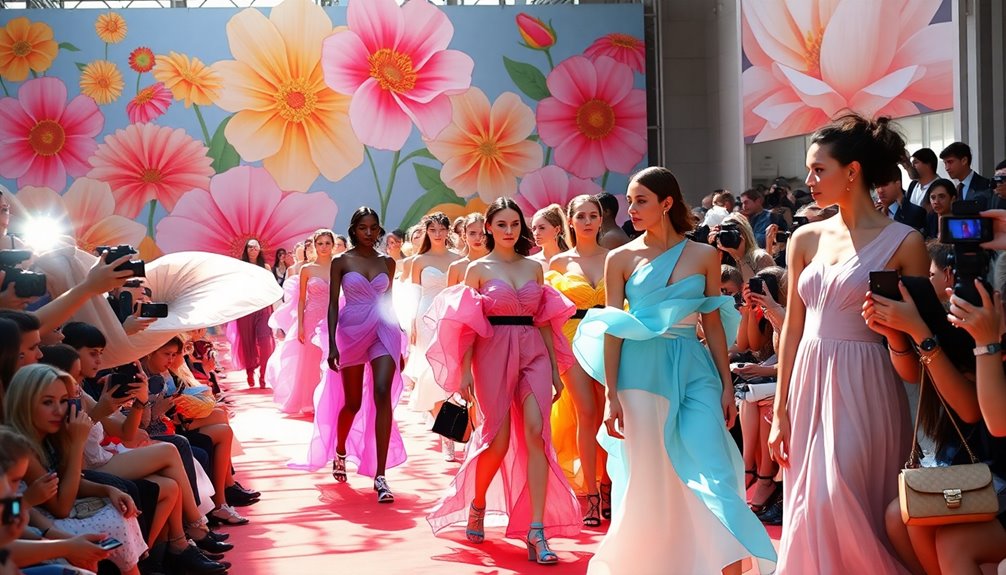The lifecycle of fashion products starts with your creative design concept, where you gather inspiration and conduct market research. You then create patterns and samples, refining them based on feedback. Next, you source materials, focusing on quality and sustainability. Production kicks in, ensuring each garment meets your design specifications. Once produced, you roll out marketing strategies to engage your target audience and build brand loyalty. Finally, you gather consumer feedback to improve continuously. Understanding these stages helps you navigate the fashion industry's complexities and respond effectively to market changes. There's much more to uncover about this fascinating process.
Key Takeaways
- The lifecycle begins with design concept creation, incorporating market research and cultural influences to develop innovative ideas.
- Material sourcing involves selecting suitable fabrics, emphasizing sustainability, quality, and supplier reputation.
- Production planning follows, utilizing efficient processes and technology to ensure high-quality garment assembly.
- Marketing strategies launch collections through events and digital platforms, engaging consumers and building brand awareness.
- Consumer feedback is essential for ongoing improvement, shaping future designs and maintaining brand loyalty throughout the product lifecycle.
Design Concept
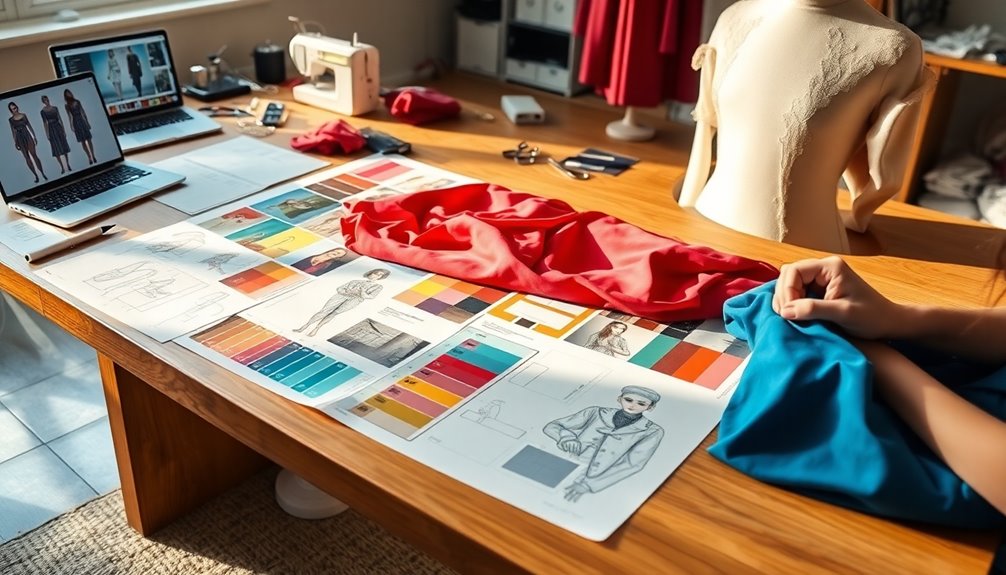
When you dive into the design concept of fashion products, it's vital to gather inspiration from a variety of sources. Art, culture, nature, and even your personal experiences can ignite creative sparks.
Start with market research and trend analysis to understand consumer behavior and demands. This initial phase helps you align your ideas with what's currently resonating in the fashion world.
Brainstorming sessions are essential for generating innovative concepts that reflect your brand's identity. Use mood boards to compile colors, textures, and themes, creating a visual representation of your ideas.
Don't forget the influence of cultural and historical movements; they can add depth to your designs. The technical drawings created during this phase are crucial for ensuring precise pattern-making and accurate measurements later on.
Understanding consumer needs is crucial for ensuring your designs are commercially viable. Analyze your target audience's age, gender, and lifestyle, aligning your designs with their fashion preferences.
Incorporate sustainability into your concept to enhance its relevance.
Finally, build your collection around a central theme or story, ensuring cohesion across all pieces. This thoughtful approach sets the foundation for a successful design concept, paving the way for the next stages in the lifecycle of fashion products. Consider the impact of iconic bags in fashion history and how they can serve as inspiration for your collection. Whether it’s the timeless elegance of the Chanel 2. 55 or the edgy, street style appeal of the Louis Vuitton Speedy, these iconic bags have left a lasting impression on the industry. By drawing from their design elements or interpreting their cultural significance, you can infuse your collection with a sense of history and reverence for fashion’s most influential accessories.
Pattern and Sample Making
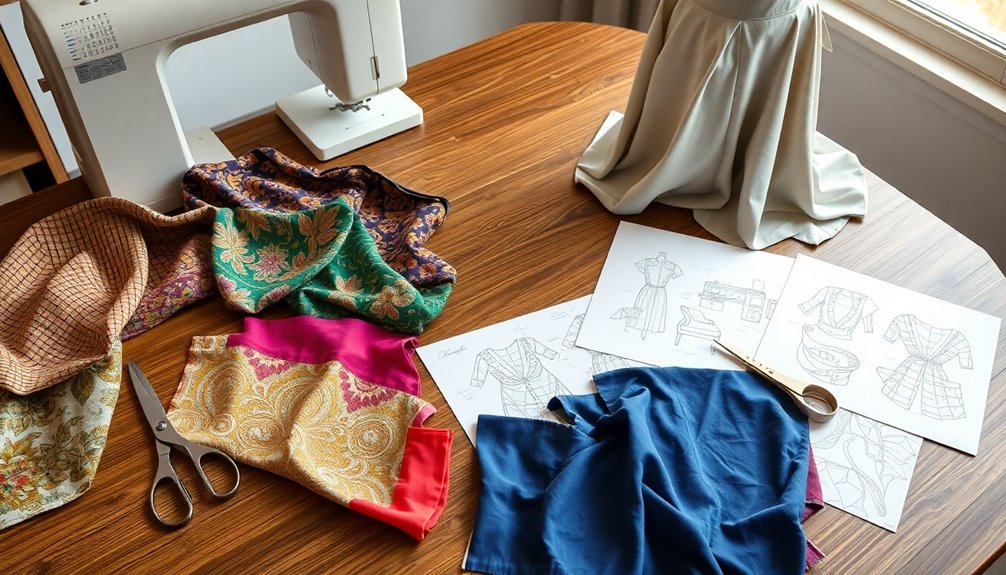
Building on your design concept, pattern and sample making is where those creative ideas become tangible garments. This stage involves translating your designs into precise measurements and shapes to ensure a perfect fit. You'll use specific tools and techniques, such as taking body measurements, drawing, cutting fabric, and making necessary fittings and adjustments. Digital pattern making can speed up the process, enhancing efficiency while minimizing physical samples, which contributes to sustainability.
There are various types of pattern making. Flat pattern making involves creating patterns on paper, while draping uses fabric directly on a mannequin for more dynamic designs. Digital techniques offer precision and quick modifications, allowing you to experiment with various styles easily. Additionally, the integration of cutting-edge tools in digital pattern making enhances accuracy and accelerates workflows.
Creating samples and prototypes is crucial for testing and refinement. These samples ensure product quality and adherence to your design specifications. You'll often create a muslin prototype to adjust for the best fit, refining darts and side seams as you go. Each fitting helps you gather feedback, essential for finalizing your pattern before mass production. This iterative process ultimately leads to garments that truly reflect your original vision.
Material Sourcing and Testing
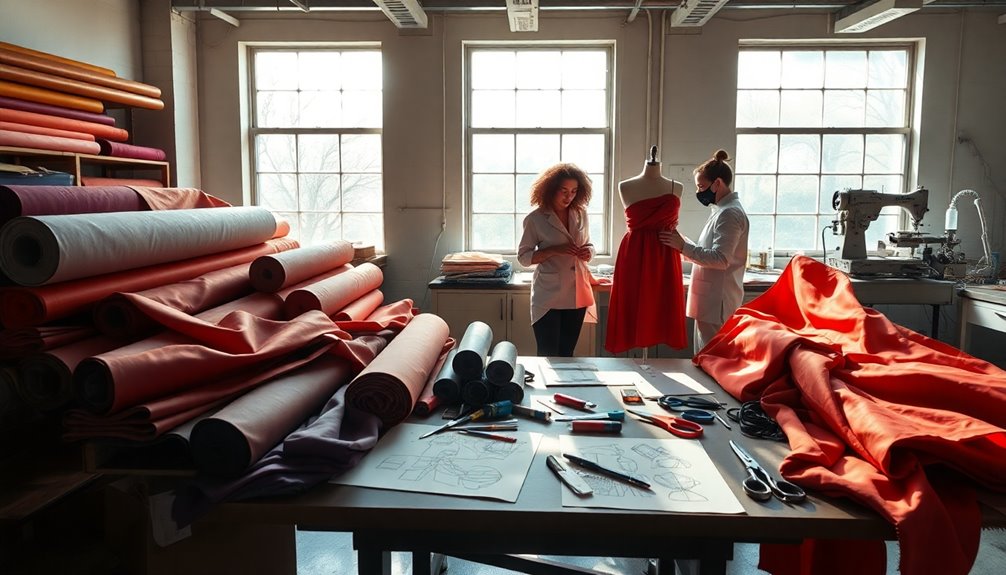
As you move into the material sourcing and testing phase, understanding consumer preferences and market trends becomes crucial for selecting the right fabrics. Start with market research to identify suitable materials that resonate with your target audience.
Consider exploring sustainable alternatives, such as organic cotton and recycled polyester, which are increasingly popular among environmentally conscious consumers. Global Sourcing can also be an effective strategy to access unique fabrics that may not be available locally. Additionally, integrating eco-friendly options in your material selections can significantly appeal to the growing demographic of sustainability-focused buyers. Furthermore, being mindful of regulatory compliance can help ensure that your material sourcing practices align with industry standards. The adoption of solar energy solutions can also be a consideration when evaluating the sustainability of your production processes. Using materials that are sourced from natural materials not only enhances quality but also aligns with the values of many modern consumers. Moreover, implementing risk-taking strategies in your sourcing decisions can lead to innovative fabric choices that differentiate your brand.
Next, evaluate the material attributes, focusing on durability, comfort, and environmental impact. This ensures you're sourcing high-quality fabrics that align with your brand values.
Assess potential suppliers based on their reputation and sustainability practices, ensuring they comply with industry regulations.
When sourcing, weigh your options between local and international suppliers. Local sourcing reduces logistics costs and environmental impact, while international options can provide a broader range of fabrics.
Don't forget to utilize traders and middlemen who can help streamline the procurement process.
Once you've sourced your materials, conduct thorough testing. Sampling allows you to evaluate quality, while durability and chemical testing ensure compliance with safety standards.
Gathering consumer feedback further refines your selection, ensuring the materials you choose meet both design specifications and user expectations.
Production Process

In the fashion industry, an efficient production process is essential to transform sourced materials into finished garments that meet consumer expectations. It all begins with production planning, where you schedule activities in advance and create a time and action calendar to track progress. This ensures that all necessary resources and personnel are allocated while coordinating with different departments to maintain efficiency. Effective planning is crucial for minimizing delays and streamlining the manufacturing process.
Don't forget to adjust plans as needed to accommodate any changes or delays.
Next, during the cutting process, pattern makers break down designs into 2D pieces. You'll utilize advanced software and laser-cutting technology for precision and minimal wastage, ensuring optimal fabric usage to reduce costs. Quality checks on cut pieces are crucial before moving forward.
In manufacturing, garments are created based on design specifications. Quality checks during this phase help catch errors early, and any issues get reported for immediate action.
Once manufacturing is complete, assembly and sewing bring everything together. You'll insert zippers, buttons, and other components, ensuring each garment adheres to production patterns and design specifications, resulting in a high-quality final product ready for consumers.
Marketing Strategies

Once the production process wraps up, it's time to turn your attention to marketing strategies that can effectively launch your fashion products into the market.
Start by introducing your new collections through eye-catching fashion shows, trade fairs, and engaging marketing campaigns. Pitch your collections to buyers, fashion editors, and influencers to create buzz. Utilize advertisements and PR events to educate potential customers and get them excited. Additionally, conducting market research can help identify consumer preferences and tailor your marketing strategies to better suit your target audience.
As your products grow in popularity, focus on increasing exposure by expanding your distribution channels.
Leverage social media advertising and engage your audience through contests and interactive content on platforms like Instagram and TikTok. Retargeting ads can help remind visitors of products they've previously viewed.
During the maturity stage, maintain brand loyalty by continuously engaging with your audience and using high-quality visuals.
Personalize your marketing efforts and participate in local events to foster connections with customers.
Finally, if you notice a decline, instill FOMO with limited-time offers and promotions.
Drive traffic to your sales pages with targeted popups. Focus on core products that have a longer lifecycle to sustain sales and keep your brand relevant.
Understanding Product Lifecycle
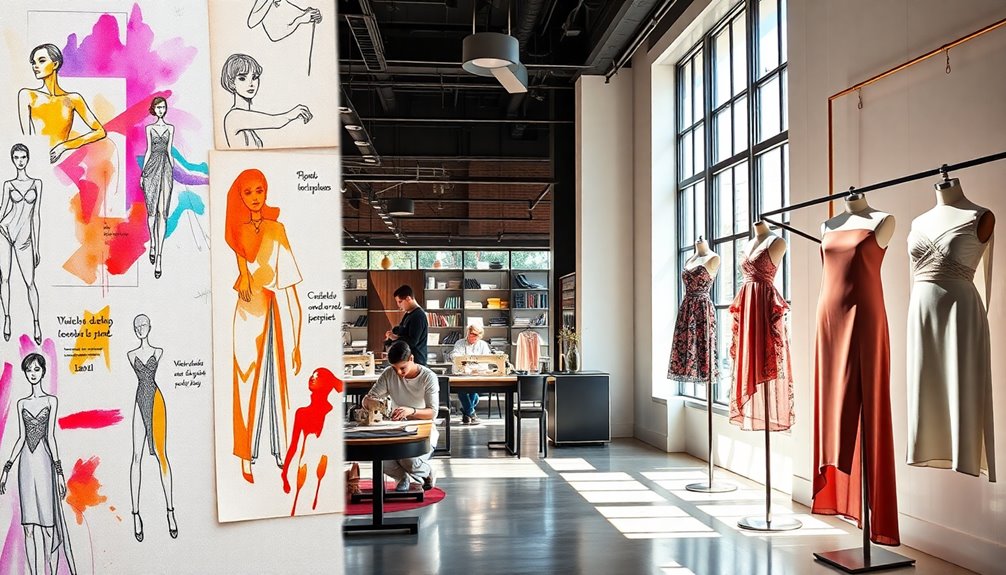
The journey of a fashion product from conception to decline is defined by its lifecycle, which consists of distinct stages that every brand must navigate.
Initially, in the Introduction Stage, you launch your product, pouring significant marketing efforts into advertisements, fashion shows, and PR events to create buzz. Here, you aim to attract early adopters and gauge market reactions.
Next is the Growth Stage, where your product experiences increasing demand. As sales rise, you ramp up production to meet this demand, while also differentiating your brand from competitors who may introduce similar offerings. This stage is crucial for establishing your market position and can be influenced by the importance of understanding product lifecycle.
In the Maturity Stage, your product becomes well-established. Sales peak, and while marketing efforts lessen, your focus shifts to maintaining market share and nurturing customer loyalty. You might introduce variations to keep the product fresh.
Eventually, you reach the Decline and Obsolescence Stage. Demand wanes as consumers shift to new trends, leading to decreased sales. At this point, you may reduce production or even discontinue the product, analyzing the entire lifecycle to gather insights for future endeavors.
Understanding these stages helps you navigate the complexities of the fashion market effectively.
Consumer Feedback and Improvement

While navigating the fashion market, leveraging consumer feedback is essential for continuous improvement and innovation. By paying close attention to customer reviews, you can gain valuable insights into preferences that shape your collections. This understanding helps you identify trends, color palettes, and styles that resonate with your audience, guiding your design decisions. Additionally, implementing continuous learning within your team can enhance your responsiveness to consumer needs.
Analyzing both positive and negative feedback reveals pain points, like sizing inconsistencies or quality issues. Addressing these concerns shows your commitment to enhancing the customer experience and fosters brand loyalty. Surveys and focus groups further deepen your understanding of consumer habits and lifestyle needs, allowing you to fill market gaps.
Moreover, consumer feedback can spotlight emerging trends, giving you a competitive edge. When multiple reviewers praise a specific feature, it signals a potential trend worth exploring. By monitoring these insights, you can align your product development with market demands. Additionally, continuous monitoring of reviews keeps brands attuned to market shifts, ensuring they remain relevant.
Ultimately, incorporating feedback into your design and product iterations ensures that future collections meet consumer expectations. This customer-centric approach not only refines your offerings but also strengthens your brand's position in the ever-evolving fashion landscape.
Frequently Asked Questions
How Long Does the Entire Fashion Product Lifecycle Typically Take?
The entire fashion product lifecycle typically spans several years, though it can vary based on the product and market dynamics.
You'll notice that the introduction stage is often short, lasting a few months to a year. After that, growth can last several years, while maturity may extend for decades.
Eventually, products enter the decline stage, which can be brief or prolonged. Ultimately, the timeline depends on consumer trends and brand strategies.
What Are the Key Roles in a Fashion Design Team?
In a fashion design team, several key roles drive the creative process.
You'll find designers who sketch and select fabrics, while creative directors ensure the vision aligns with the brand.
Stylists bring that vision to life, and market researchers keep an eye on trends.
Production roles include managers and pattern makers, while marketing involves managers and photographers.
Each role contributes to the overall success of the collection, making collaboration essential.
How Is Sustainability Integrated Into Fashion Product Development?
Sustainability's integrated into fashion product development by prioritizing eco-friendly materials like organic cotton, bamboo, and recycled polyester.
You'll find brands adopting zero-waste manufacturing and energy-saving practices, minimizing their environmental impact.
Ethical labor practices ensure workers are treated fairly, while transparent supply chains foster accountability.
What Challenges Arise During the Production Phase?
During the production phase, you face several challenges that can impact product quality and efficiency.
Inconsistent quality control might lead to defects, causing customer complaints. You'll also navigate complex supply chains, where communication gaps can disrupt processes.
Additionally, fluctuating demand makes inventory management tricky; overproduction can waste resources while underproduction risks lost sales.
Ethical manufacturing and sustainability issues further complicate your efforts, requiring careful attention to regulations and practices across different regions.
How Do Fashion Trends Influence Product Design Decisions?
Fashion trends heavily influence your product design decisions.
You'll analyze market research and consumer feedback to identify what's popular. Incorporating these insights, you sketch and develop prototypes that resonate with current aesthetics.
You might collaborate with influencers to validate your ideas, ensuring they align with consumer desires.
Conclusion
In the fashion industry, understanding the lifecycle of a product is crucial for success. By grasping each stage—from design concept to consumer feedback—you can create products that resonate with your audience. Staying attuned to trends and consumer preferences ensures your designs remain relevant. Don't forget to gather feedback and make improvements; it's all part of the journey. Embrace these phases, and you'll not only enhance your brand but also foster lasting connections with your customers.
